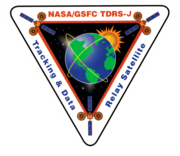| TDRS-10 | ||
|---|---|---|
 El TDRS-J antes de su lanzamiento | ||
| Tipo de misión | Satélite de comunicaciones | |
| Operador | NASA | |
| ID COSPAR | 2002-055A | |
| no. SATCAT | 27566 | |
| ID NSSDCA | 2002-055A | |
| Página web | enlace | |
| Duración de la misión | 11 años (planeado) | |
| Propiedades de la nave | ||
| Modelo | Boeing 601 | |
| Fabricante | Boeing Satellite Development Center | |
| Masa de lanzamiento | 3.180 kg | |
| Comienzo de la misión | ||
| Lanzamiento | 5 de diciembre de 2002 | |
| Vehículo | Atlas II | |
| Contratista | International Launch Services | |
| Parámetros orbitales | ||
| Altitud del periastro | 35.766 km | |
| Altitud del apastro | 35.798 km | |
| Inclinación | 6,09 grados | |
 Insignia de la misión TDRS-10 | ||
El TDRS-10, conocido antes del lanzamiento como TDRS-J, es un satélite de comunicaciones estadounidense operado por la NASA y construido por Boeing como parte del Tracking and Data Relay Satellite System.[1]
YouTube Encyclopedic
-
1/3Views:95 90014 3403 679
-
Memories of Childhood - We Too are Human Beings | Vistas Chapter - 8 Part - 2 | in Hindi
-
Lec 10 | MIT 16.885J Aircraft Systems Engineering, Fall 2005
-
L21: Balance of Payments | Crack UPSC CSE 2020 | UPSC CSE/IAS 2020 | Vishnu Agarwal
Transcription
Lanzamiento
Se utilizó un cohete Atlas IIA[2] para lanzar el TDRS-J, en virtud de un contrato con International Launch Services.[3] El lanzamiento se produjo a las 02:42 UTC del 5 de diciembre de 2002, desde el complejo de lanzamiento 36A en la Estación de la Fuerza Aérea de Cabo Cañaveral. Tras el lanzamiento el TDRS-10 se separó de su cohete portador en una órbita de transferencia geosincrónica. A las 01:00 UTC del 14 de diciembre, tras una serie de encendidos de su motor, alcanzó la órbita geoestacionaria.
Referencias
- ↑ «TDRS 8,9,10». Consultado el 25 de septiembre de 2018.
- ↑ Astronautix. «Atlas IIA». Consultado el 25 de septiembre de 2018.
- ↑ «December 2002 - Tracking and Data Relay Satellite 10 (TDRS-10) Launched».
